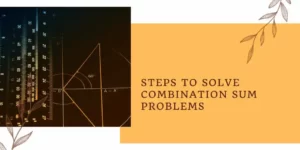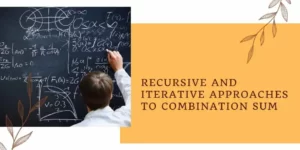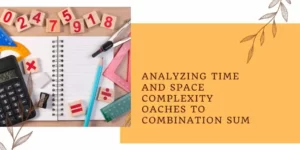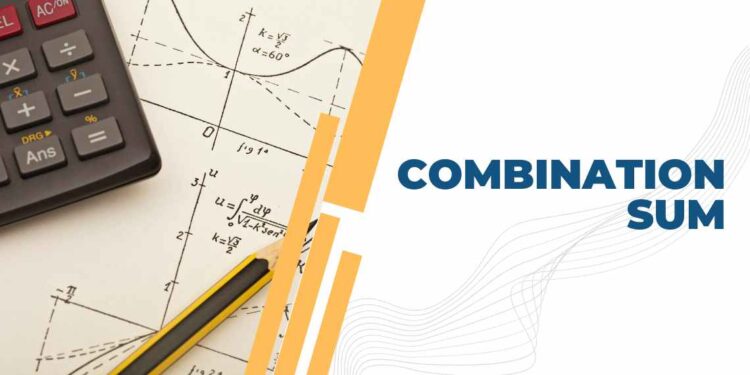Table of Contents
ToggleIntroduction
Combination Sum is a classic problem in the field of Computer Science and Mathematics. The problem asks to find all possible unique combinations of a given set of numbers that add up to a target sum. For example, if we have the set of numbers [2, 3, 6, 7] and the target sum is 7, then the unique combinations that add up to the target sum are [2, 2, 3] and [7].
To solve the Combination Sum problem, we typically use a backtracking algorithm. The algorithm starts by sorting the input array and then exploring all possible combinations in a recursive manner. At each step, the algorithm selects a number from the input array and adds it to the current combination.
If the sum of the combination exceeds the target sum, the algorithm backtracks and tries another number. If the sum of the combination equals the target sum, the algorithm adds the combination to the result set. The algorithm continues until all possible combinations have been explored.
The time complexity of this problem is exponential, as the number of possible combinations grows with the input size. However, there are several optimizations that can be used to improve the performance of the algorithm, such as pruning the search space and memoization. This is a fundamental problem in computer science and has many applications, including in data analytics, machine learning, and optimization.
Types of Combination Sum Problems

There are two types of such problems: Unique Solutions and Non-Unique Solutions.
In the case of Unique Solutions, the problem asks to find all possible unique combinations of numbers from a given set that add up to a target sum. In this case, each combination is unique, meaning that no two combinations have the same set of numbers. For example, if we have the set of numbers [2, 3, 6, 7] and the target sum is 7, then the unique combinations that add up to the target sum are [2, 2, 3] and [7].
While, in the case of Non-Unique Solutions, the problem asks to find all possible combinations of numbers from a given set that add up to a target sum, regardless of whether the combinations are unique or not.
In this case, the same set of numbers can be used multiple times to create different combinations that add up to the target sum. For example, if we have the set of numbers [2, 3, 6, 7] and the target sum is 7, then the non-unique combinations that add up to the target sum are [2, 2, 3], [2, 2, 2, 1], [1, 1, 1, 1, 1, 1, 1, 1], and so on.
The approach to solving these types of problems is slightly different. In the case of unique solutions, we can use a backtracking algorithm to generate all possible combinations while avoiding duplicates.
In the case of non-unique solutions, we can use dynamic programming to store all possible combinations and their corresponding sum and then generate the desired output.
Backtracking Algorithm- How It Enables Efficient Combination Sum Computation
The Backtracking Algorithm is a common technique used to solve Combination Sum problems, especially those that require finding unique solutions. The algorithm enables efficient computation by exploring all possible combinations in a recursive manner while avoiding duplicate combinations. Click here to know more about full stack development course London
The algorithm starts by sorting the input array and then exploring all possible combinations in a depth-first search manner. At each step, the algorithm selects a number from the input array and adds it to the current combination.
If the sum of the combination exceeds the target sum, the algorithm backtracks and tries another number. If the sum of the combination equals the target sum, the algorithm adds the combination to the result set. The algorithm continues until all possible combinations have been explored.
The backtracking algorithm is efficient because it avoids generating duplicate combinations by only selecting numbers that come after the current index in the input array. This is because combinations that include numbers before the current index have already been explored in previous recursive calls. Therefore, the algorithm prunes the search space and avoids generating unnecessary combinations.
Additionally, the algorithm can be further optimized by adding memoization, which caches the previously computed results and reuses them instead of recomputing them. This reduces the number of recursive calls and improves the overall performance of the algorithm.
The Backtracking Algorithm enables efficient computation by exploring all possible combinations while avoiding duplicates and reducing unnecessary computation through pruning and memoization.
Steps to Solve Combination Sum Problems

The following are the steps to solve such type of problems:
Understand the Problem: Read and understand the problem statement, including the input and output requirements, constraints, and examples.
Choose an Algorithm: Choose an algorithm that is appropriate for the problem type, such as the Backtracking Algorithm for unique solutions or Dynamic Programming for non-unique solutions.
Design the Algorithm: Design the algorithm, including the data structures, control flow, and termination conditions.
Implement the Algorithm: Implement the algorithm in a programming language, taking care to handle edge cases and error handling.
Test the Algorithm: Test the algorithm using the provided test cases and additional test cases, making sure that the output is correct and meets the requirements.
Optimize the Algorithm: Optimize the algorithm by improving the time and space complexity, reducing the number of operations, and implementing memoization.
Submit the Solution: Submit the solution, along with any required documentation or explanation of the algorithm and its performance.
It is important to break down the problem into smaller subproblems, verify assumptions, and iterate on the solution until it meets the requirements and is optimized for performance. Additionally, it is important to communicate with stakeholders, such as the problem owner or other team members, to clarify requirements and ensure alignment on the solution approach.
Recursive and Iterative Approaches to Combination Sum

There are two main approaches to solving these problems: recursive and iterative. Each approach has its own pros and cons.
The Recursive Approach involves solving the problem by recursively exploring all possible combinations of the input array, checking if each combination sums up to the target sum. It is easy to understand and implement and works well for problems with small input sizes.
However, it can lead to stack overflow errors when the input size is large, and it can be slower than the iterative approach due to the overhead of function calls.
The Iterative Approach involves solving the problem using a loop that iteratively generates all possible combinations of the input array, checking if each combination sums up to the target sum.
The iterative approach is more memory-efficient than the recursive approach, a
s it avoids the overhead of function calls and does not suffer from stack overflow errors. It can also be faster than the recursive approach for large input sizes, as it avoids the overhead of function calls. Also read about data science course Manchester
However, the iterative approach can be harder to understand and implement than the recursive approach, especially for more complex problems. Additionally, the iterative approach may require more complex data structures to efficiently generate combinations, such as queues or stacks.
The choice between the recursive and iterative approaches depends on the specific problem requirements, input size, and complexity. In general, the recursive approach is preferred for small input sizes and simple problems, while the iterative approach is preferred for larger input sizes and more complex problems.
Analyzing Time and Space Complexity

For the recursive approach, the time complexity is usually exponential, as it explores all possible combinations of the input array. Combination Sum, The number of recursive calls is directly proportional to the input size and the target sum, resulting in an O(2^n) time complexity in the worst case, where n is the input size.
The space complexity is also exponential, as the algorithm uses a call stack to store the intermediate results. Therefore, the space complexity is also O(2^n) in the worst case.
For the iterative approach, the time complexity is also exponential in the worst case, but it can be improved by using dynamic programming or memoization. Without any optimization, the time complexity is O(k * 2^n), where k is the average size of the combinations that sum up to the target sum. The space complexity of the iterative approach is usually O(k), as it only needs to store the current combination and some additional variables.
Therefore, to optimize these algorithms, it is important to consider the input size, target sum, and average size of the combinations. Dynamic programming and memoization can be used to improve the time complexity while avoiding the recursive approach can help reduce the space complexity.
Additionally, pruning and early termination techniques can also be used to reduce the number of unnecessary operations and improve the overall performance of the algorithm.
Applications of Combination Sum
This problem has a wide range of real-world applications, including:
Finance: Algorithms like summing one can be used to optimize a portfolio of investments, where the target is to achieve a specific return by selecting a combination of assets that sum up to the desired return.
E-commerce: It can be used to recommend products to customers based on their past purchases, by selecting a combination of related products that are likely to be of interest to the customer.
Gaming: The technique to solve such problems can be used to generate all possible combinations of items or abilities in a game, allowing players to experiment with different strategies and playstyles.
Transportation: Such techniques can be used to optimize the routing of vehicles, where the target is to minimize the total distance traveled or the total time spent on the road by selecting a combination of routes that cover all destinations.
Manufacturing: Combination Sum can be used to optimize the production of goods, where the target is to maximize the output by selecting a combination of resources, such as raw materials and machines, that can produce the most units in the shortest time.
In general, This algorithm can be used in any problem where the target is to find a combination of elements that satisfy certain constraints or objectives. By exploring all possible combinations, Combination Sum can provide optimal or near-optimal solutions to complex problems, making it a valuable tool in various fields.
Advanced Techniques for Combination Sum
Memoization and Dynamic Programming are advanced techniques for optimizing these algorithms, reducing their time complexity, and improving their performance.
Memoization involves storing the results of intermediate subproblems in a lookup table so that they can be reused later without recomputing them. This approach can greatly reduce the number of redundant computations, as it avoids exploring the same combination more than once.
By caching the results of the subproblems, the time complexity can be reduced from exponential to polynomial, resulting in a significant improvement in performance.
Dynamic Programming is a more general technique that involves breaking down a problem into smaller subproblems and solving them in a systematic and recursive manner. This approach can help avoid redundant computations and identify optimal solutions by building up a solution from smaller subproblems.
In this algorithm, dynamic programming can be used to generate all possible combinations of the input array that sum up to the target sum, by iterative computing and storing the results of intermediate subproblems.
Both memoization and dynamic programming require additional memory to store the lookup tables or intermediate results, but the trade-off is a significant reduction in the time complexity and an improvement in the overall performance of the algorithm.
In summary, memoization and dynamic programming are advanced techniques for optimizing such algorithms, reducing their time complexity, and improving their performance. By storing the results of intermediate subproblems and breaking down the problem into smaller subproblems, these techniques can help avoid redundant computations and identify optimal solutions efficiently.
Common Mistakes to Avoid While Solving Combination Sum Problems
These summing problems combinational can be tricky and require careful attention to detail. Here are some common mistakes to avoid while solving such problems:
Missing or Duplicating Elements: Ensure that all elements in the input array are included in the solution and that they are not duplicated. Missing or duplicating elements can result in incorrect solutions.
Incorrect Base Cases: For recursive solutions, ensure that the base cases are correctly defined to avoid infinite loops or incorrect solutions.
Not pruning or Early Terminating: Pruning or early terminating can greatly improve the performance of the algorithm by avoiding unnecessary computations. Ensure that the algorithm is optimized to avoid exploring redundant or unnecessary combinations.
Not Considering Edge Cases: Consider edge cases, such as empty input arrays or target sums of zero, and ensure that the algorithm can handle them correctly.
Not Optimizing for Time or Space Complexity: Ensure that the algorithm is optimized for both time and space complexity and that the trade-offs are carefully considered. Recursive solutions can be exponential in time and space complexity, while iterative solutions can be more efficient but may require more memory.
Not Testing with Multiple Test Cases: Test the algorithm with multiple test cases to ensure that it works correctly for different inputs and edge cases.
By avoiding these common mistakes and thoroughly testing the algorithm, one can improve the accuracy, efficiency, and performance of the Combination Sum solution.
Tips and Tricks for Mastering Combination Sum
Mastering Combination Sum can be challenging, but with practice and dedication, it can be a rewarding experience. Here are some tips and tricks to help you master this algorithm:
Understand the Problem: Make sure you understand the problem statement and
constraints before attempting to solve the problem. Break down the problem into smaller subproblems and identify patterns that can help you come up with a solution.
Choose the Right Approach: Choose the appropriate algorithmic approach, whether recursive, iterative, memoization, or dynamic programming, depending on the problem constraints and complexity.
Optimize for Time and Space Complexity: Consider the trade-offs between time and space complexity and choose an algorithm that optimizes both.
Test with Multiple Test Cases: Test the algorithm with multiple test cases to ensure that it works correctly for different inputs and edge cases.
Practice, Practice, Practice: The more you practice, the better you will become at solving these problems. Participate in coding challenges and competitions, and work on practice problems to improve your skills.
Collaborate with Others: Collaborate with other programmers and learn from their experiences. Share your code and receive feedback to improve your coding style and efficiency.
By following these best practices and continuing to practice, learn, and collaborate with others, you can master Combination Sum and become a skilled problem solver.
Conclusion
Combination Sum is an important algorithmic problem that involves finding all possible combinations of elements in an input array that sum up to a given target sum. It has many practical applications, such as in financial analysis, data mining, and machine learning.
There are various approaches to solving such problems, including recursive, iterative, memoization, and dynamic programming. Each approach has its own advantages and disadvantages, and the choice of algorithm depends on the problem constraints and complexity.
To successfully solve these problems, it is important to understand the problem statement and constraints, choose the appropriate algorithmic approach, optimize for time and space complexity, and test the algorithm with multiple test cases. By practicing and collaborating with other programmers, one can become a skilled problem solver and master this algorithm.
Combination Sum is a challenging yet rewarding problem that can help improve one’s algorithmic and problem-solving skills. It is a valuable tool for solving real-world problems and can be applied in a wide range of fields.
Frequently Asked Questions
What is Combination Sum?
Combination Sum is an algorithmic problem that involves finding all possible combinations of elements in an input array that sum up to a given target sum.
What are the types of Combination Sum problems?
There are two types of Combination Sum problems: unique solutions, where each combination is unique, and non-unique solutions, where duplicates are allowed.
What is backtracking and how is it used in Combination Sum?
Backtracking is a technique used in Combination Sum that involves exploring all possible solutions and pruning unnecessary computations to improve efficiency.
What is memoization and how is it used in Combination Sum?
Memoization is a technique used in Combination Sum that involves storing previously computed results to avoid redundant computations and improve efficiency.
What are some common mistakes to avoid when solving Combination Sum problems?
Common mistakes to avoid when solving Combination Sum problems include missing or duplicating elements, not defining correct base cases, not pruning or early terminating, not considering edge cases, not optimizing for time or space complexity, and not testing with multiple test cases.













